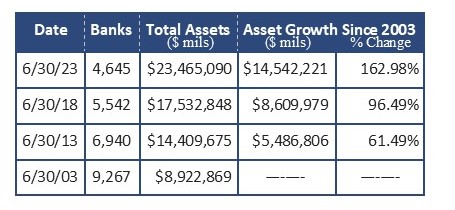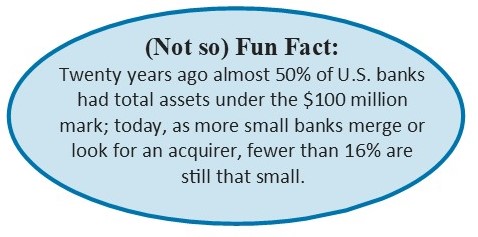In the past 20 years, the number of banks in the United States has been cut in half while industry assets have grown by 163%.
Some of this is due to mergers and acquisitions as the industry has consolidated. Upon further examination, however, there is much more to the story than meets the eye.
Bauer's Historical Bank Generator Report Provides side-by-side financial data for 5 quarters of your choice (compare year-ends or historical year-over-year quarters) on any FDIC-Insured U.S. bank. This report includes balance sheet and income statement data as well as a number of key ratios and peer comparisons.
Bank Growth Has Taken Flight
In the past 20 years, the number of banks in the United States has been literally cut in half (from 9,267 at the end of June 2003 to 4,645 at the end of June this year). Industry assets during that same timeframe, have ballooned, growing 163% (see chart below).
Growth is a good thing. In fact, if you’re not growing, you’re dying, at least in business. In the past year, only two U.S. banks reported a 50% decline (or more) in assets. Both are winding down their operations, but for different reasons.
The first is 5-Star Bank of Jackson Hole, WY, which, as of October 2022, is a Trust Company. As such, its deposits have dropped from $1.5 billion a year ago to exactly $1 million today. Its assets have gone from $1.66 billion to just under $40 million during that 12 month period.
The other of course, is Zero-Star Silvergate Bank, CA. Similar to Silicon Valley Bank (SVB), Silvergate was highly dependent on the crypto industry. Unlike SVB, which was shut immediately, Silvergate was allowed to limp away to wind itself down in a more orderly fashion.
Growing too quickly can lead to some unintended consequences as well. A prime example of this is a bank we reported on in July (JRN 40:25 re: Independence Day) 3-Star Old Glory Bank, Elmore City, OK.
At that time, we only had first quarter 2023 financial data, so we reported, rightfully, that Old Glory was a $22 million bank. We also noted it had received a sizable capital injection that it was using to expand its reach. That expansion resulted in total asset growth of 145% during the second quarter. It also was the cause of its star-rating dropping from 5-Stars based on 9/30/2022 data to 3-Stars today.
The 50 banks with the highest percent of asset growth during the 12 months ending June 30, 2023 are listed on page 5 in descending order of asset growth. Now a $54 million bank, Old Glory is number 3. (Had we run this list based on the highest quarterly change, Old Glory would have easily been number 1.)
Instead, the bank in the number 1 spot is JRN listee 4-Star Allied First Bank, Oswego, IL, with year-over-year asset growth of 392%!
Allied First Bank was originally established in 1994 as Allied Pilots Association Federal Credit Union. Shortly after the turn of the century, Allied changed its charter to become a mutual savings bank and also converted to stock ownership via Allied First Bancorp, Inc. a newly created holding company.
Things remained quiet for Allied until around the start of the pandemic in the United States. At that time, a couple of online stock writers noticed Allied and wrote about its very attractive return on equity (ROE). That was it. The cat was out of the bag.
Last September (2022) ServBanc Holdco, Inc. was established in Phoenix, AZ for the sole purpose of acquiring the small Illinois bank. ServBanc is led by Mr. Stavros Papastavrou, a Greek immigrant known primarily for founding and leading The Money Source Inc., a fintech provider and mortgage servicing provider since 1997.
That gives us an idea of where Allied will be headed next. It is already heavily reliant on residential real estate, with 89% of its loan portfolio in home loans. We can expect that loan portfolio (currently $112.6 million) to grow exponentially. In the past year, Allied has already doubled its employees and more than quadrupled its asset size.
We have just had two examples of asset growth that did not involve a merger of banks. Here’s one with another twist. In January 2022 (JRN 39:05) we wrote:
The OCC just issued conditional approval for the large fintech company, SoFi Technologies to become a national bank. The Fintech will acquire 5-Star Golden Pacific Bank, N.A., Sacramento, CA. SoFi Bank intends to inject $750 million in capital to pursue its national digital plan, while maintaining Golden Pacific’s three branches and community bank business.
And so it was, sort of. In order to accomplish this, SoFi had to create an interim bank, aptly named SoFi Interim Bank, which then merged with “and into” Golden Pacific Bank. Handling the combination this way allowed the continuity of Golden Pacific’s history and charter. Even though, 5-Star SoFi Bank, NA, (headquartered in Utah, which has fewer restrictions), is nothing like its predecessor.
Looking at the transaction from the holding company level, Golden Pacific Bancorp, Inc., the holding company for Golden Pacific Bank no longer exists. It was acquired by Social Finance Inc. (SoFi Banks’ holding company). This is a round about way for a Fintech to get a bank charter. But it worked.




1 comment on “Bank Growth Has Taken Flight”
Comments are closed.